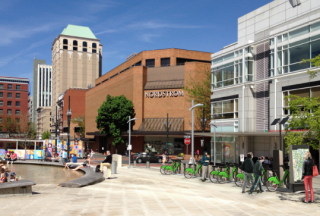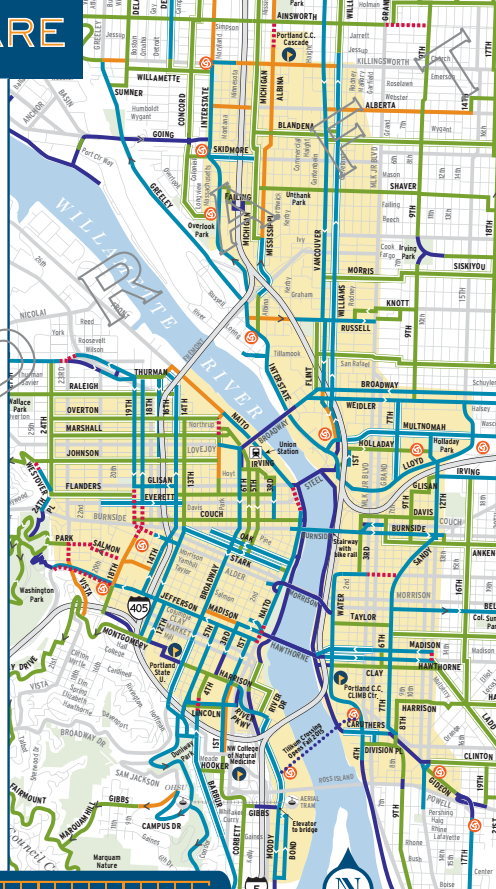
in downtown’s Director Park.
(Image: Motivate)
Portland has been accustomed to auto-parking/bike-lane tradeoffs for years. Now it’s about to encounter a new tradeoff: auto-parking/bike-share-station.
A round of five city open houses this spring will start the public conversation about where to put the stations for the bike sharing system Portland plans to launch by July. And though some locations are probably no-brainers (Director Park, Pioneer Courthouse Square, Urban Center Plaza, Jamison Square, Union Station, Holladay Park, Rose Quarter Transit Center, Little Big Burger on Mississippi…) others will be harder.
As we mentioned in yesterday’s post about Seattle’s bike share struggles, the ideal distance between bike share stations seems to be no more than five blocks, the more evenly spaced the better. Portland won’t be able to meet that standard in much of its area, but it’s a star to aim for where possible.

Fortunately, Portland has a lot of firsthand experience with the benefits of bike parking. Nearly every single one of the city’s 130+ bike parking corrals has been installed with support from neighboring retailers, and they’re so efficient (in terms of “customer wallets per square foot of parking space”) that some businesses even pay to jump to the front of the city’s queue.
Successful bike-share stations seem to have a similar effect; a 2013 survey of people in Washington D.C. business districts found that 66 percent of Capital Bikeshare users are on their way to spend money somewhere, overwhelmingly at businesses within a few blocks of a station.
Advertisement
Putting bike-share stations near mass transit stations is important, too — probably for the sake of both bike sharing and transit. A 2014 study found that the two modes are complementary, and that a 10 percent increase in Capital Bikeshare ridership tends to happen alongside a 2.8 percent increase in Metro rail ridership.
Biketown’s “smart bike” system adds an interesting twist to all this: in a sense, when we talk about “stations” on Portland’s bike sharing system, we’re basically just talking about invisible columns of air around which the system has drawn a digital “geofence.” Park your Biketown ride anywhere inside the column (which will probably be about the size of a city block face) and a satellite will detect that you’re in the “station,” even if you’re not locked to one of the system’s specially branded racks.

(Photo: City of Orlando)
So if businesses or residents get upset about a particular station location, it could be tempting for the city to say “OK, we’ll just make it a completely virtual station.”
That could be a useful tool. One of the unique strengths of Biketown will be that its bikes will be able to spill into nearby bike staples and corrals as needed; no station will ever be completely full. And the chance to put a station where it “should” be with zero political pushback might be good.
The only reason Biketown will have physical stations at all is to make the system visible, memorable and special.
But here’s the potential downside of “smart bike” systems: Biketown is going to need to feel like a thing. The only reason Biketown will have physical stations at all is to make the system visible, memorable and special. When I’m Biketowning to the coffee shop, I don’t want to have to pull out my phone and open an app to figure out whether I can park on a certain block. I just want to see a station and lock up.
So for Biketown to serve the riders (and deliver the customers) that we all want it to, it’s going to need stations with a physical presence.
Here are the open houses where the city will start figuring out where to put them:
March 15th (Tuesday) – 5:30 – 7:30 pm, SE Portland location TBD
March 17th (Thursday) – Noon – 2:00 p.m., City Hall, Lovejoy Room, 1221 SW 4th Avenue
March 30th (Wednesday) – 5:00 – 7:00pm, Portland Building, 1120 SW 5th Avenue
April 5th, (Tuesday) – 6:00 – 8:00pm, NW Portland location TBD
April 7th (Thursday) – 5:30 – 7:30pm, Immaculate Heart Church, 2926 N Williams Avenue
The city also says it will launch an online map on March 9 asking people to submit station sites. (Some readers will remember that the city did the same thing a few years ago; you can see Portlanders’ answers at the bottom of this post.)
— Michael Andersen, (503) 333-7824 – michael@bikeportland.org
BikePortland can’t survive without paid subscribers. Please sign up today.

